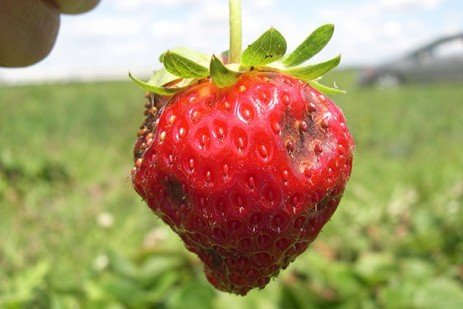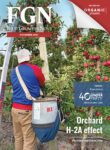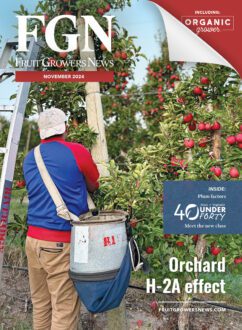May 22, 2019Mid-Atlantic continues to see problems with anthracnose in strawberries
Anthracnose is caused by fungi in the genus Colletotrichum, and has been affecting mostly plasticulture plantings, but also matted-row plantings of susceptible cultivars. Some strawberry growers in southeastern Pennsylvania have already been finding their green fruit to be infected with anthracnose this year, despite cool, wet conditions that would more typically be associated instead with botrytis, our other major strawberry disease. This article attempts to answer some common grower questions regarding anthracnose fruit rot, and how to best manage it.
Symptoms to watch out for
Berry flowers may be blighted, though this is difficult to tell apart from blossoms blighted by botrytis. Affected berry caps and leaves may show brown or black spots with irregular margins (i.e., spots won’t be perfectly round like with common leaf spot or leaf scorch in early stages), and runners and petioles may show oval to elongated lesions that are brown or black. Tiny orange masses of spores may develop close to the center of these lesions under favorable conditions. Mostly growers notice symptoms on fruit, which may first show up as hard brown lesions when the fruit is green. Seeds may be blackened. Early symptoms on ripe fruit appear as small sunken areas without much color. As the disease progresses and fruit ripens, fruit lesions become sunken and brown, and then an orange coloration develops in the sunken area as spores are produced.
Anthracnose causing blight of strawberry blossoms. Photo: Tim Elkner/Penn State Extension
Anthracnose causing blackening of green fruit and blossom blight. Photo: Tim Elkner/Penn State Extension
Anthracnose lesion on ripening ‘Albion’ fruit. Note irregular brown spots on the cap. Photo: Kathy Demchak/Penn State Extension
Sunken area caused by anthracnose fruit rot on ‘Monterey’ fruit before the development of orange spore masses. Photo: Kathy Demchak/Penn State Extension
Where does anthracnose come from?
In most but not all cases, it appears that nurseries are the primary source of the disease, especially for plug plants, but this doesn’t mean that the problems originated with the plug propagator. Plant material used for plug plants sometimes takes a maze-like route through a few states and provinces before finally arriving at a propagator’s greenhouse, and then at the grower’s farm. At this stage, the fungi that cause anthracnose may co-exist within the strawberry plant tissue without causing any symptoms at all (referred to as quiescent or latent infections), until the fungus senses that conditions are right for sporulation. For us in the eastern U.S., this means moisture and high humidity, and moderate to warm temperatures (though this spring, we haven’t had those yet). When sugar level rises as strawberry fruit ripen, the fungus can easily infect and develop lesions on the fruit. Add to that splashing water from rain on plastic that bounces slimy spores around, and suddenly a large proportion of the fruit becomes infected.
Although anthracnose needs plant tissue to survive, if badly infected fruit that dried up and mummified are in the field, the anthracnose fungus can survive on those fruit until they completely decompose, which can take a year or two.
C. acutatum and C. gleosporoides “complexes” – What does this mean?
With technology improvements, it comes a better understanding of the genetics of plant diseases, and there is a lot more genetic diversity in anthracnose fungi than was known (or perhaps, than we had hoped). What had been diagnosed in the past as anthracnose fruit rot or anthracnose crown rot, and was thought to be caused by one of two Colletotrichum species, was likely caused by other closely-related species that are similar in appearance to these two species. Species in both of these groups can affect a variety of plants including weeds, so could move to or from other susceptible plants in the surrounding environment.
To help sort this out, this summer, a project is underway at the University of Maryland in collaboration with Penn State and Virginia Tech extension, to better understand which anthracnose species are present in mid-Atlantic strawberry fields. Samples are being tested from Maryland, Pennsylvania, and Virginia. While not every sample can be tested, we are attempting to assemble a representative set of samples from across the region that will give us a better handle on the situation. The primary goal is to understand distribution, prevalence, and potential cultivar specificity of each Colletotrichumspecies in the mid-Atlantic States.
How much fungicide resistance is “out there”?
While resistance to some strobilurin (aka QoI) fungicides has been documented in anthracnose, the constantly wet conditions for over a year probably diminished fungicide coverage and effectiveness on grower and nursery farms, causing plenty of inoculum to be present. Spray recommendations have been changed somewhat to minimize resistance development while still obtaining reasonable control (see below) and will continue to be modified as newer materials and information about anthracnose becomes available. It’s also possible that some of the related species discussed in the paragraph above may never have been sensitive to certain fungicides in the first place, rather than developing resistance to them.
Minimize anthracnose with cultural methods
Any cultural method that minimizes rain splash will help, such as using straw mulch along the edges of and between the rows and plants, including in plasticulture. Only a few varieties have significant resistance to anthracnose – ‘Flavorfest’ is less susceptible than ‘Chandler.’ ‘Sweet Charlie’ is somewhat resistant also, but its yields are quite low. Day-neutral varieties are typically very susceptible. Inoculum can be moved around on the equipment and harvester’s hands, so it makes sense to work in less badly affected areas ahead of those where the disease is worse. Low tunnels decrease anthracnose incidence greatly, and high tunnels essentially eliminate fruit symptoms even without the use of fungicides and thus may be especially useful for organic growers.
How should my spray program for anthracnose look?
Current recommendations for 2019 are in the Mid-Atlantic Vegetable Production Guide in the section entitled “Strawberries.” The spray program recommends keeping a non-systemic protectant (captan) on the plants at the maximum labeled rate ahead of symptom development, starting at 10% bloom and then applying every 7 to 10 days, though wet periods may require shortening the interval. This allows eight applications of captan during the course of a year.
During periods of highest disease pressure, add a group 11 fungicide labeled for strawberries (for example, Abound, Evito or Aftershock, or Cabrio), or better yet, a fungicide that is a combination of group 11 and group 3 (examples are Quadris Top or Quilt Xcel), or group 11 combined with group 7 (such as Luna Sensation, Merivon or Pristine) ingredients to the tank with captan for a maximum of two sequential applications or preferably, two total during the season. Switch (with active ingredients in groups 9 and 12) can be added to captan in the same way but is also limited to two sequential applications during a season. Pre-harvest and re-entry intervals for these products are relatively short but vary, so be sure to check product label information.
There is a disease forecasting system available for anthracnose that is currently being tested in the mid-Atlantic region, SAS – Strawberry Advisory System, testing led by Dr. Mengjun Hu at the University of Maryland, developed by Dr. Natalia Peres at the University of Florida. And there’s another in development for the NEWA system based on data from Mike Ellis, Ohio State University and Dr. Natalia Peres, University of Florida; development led by Kerik Cox and Julie Carroll at Cornell University. However, if the weather continues to be as wet as it’s been so far this year, keeping fungicides on the plants will be a challenge, and growers may just need to make fungicide applications whenever soil conditions allow access to the field.
– Kathy Demchak and Timothy Elkner, Penn State Extension; and Mengjun Hu, assistant professor, University of Maryland.
Photo at top: Symptoms of advanced fruit anthracnose. Note orange color especially around seeds in infected area. Photo: Kathy Demchak/Penn State Extension



















